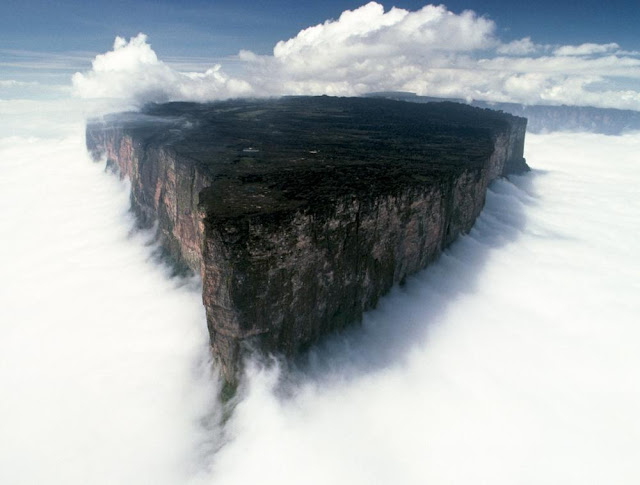Mount Roraima,also known as Tepuy Roraima and Cerro Roraima; Portuguese: Monte Roraima is the highest of the Pakaraima chain of tepui plateaus in South America.[4]:156 First described by the English explorer Sir Walter Raleigh in 1596, its 31 km2 summit area:156 is bounded on all sides by cliffs rising 400 metres.The mountain also serves as the triple border point of Venezuela, Guyana and Brazil.
Mount Roraima lies on the Guiana Shield in the southeastern corner of Venezuela's 30,000-square-kilometre Canaima National Park forming the highest peak of Guyana's Highland Range. The tabletop mountains of the park are considered some of the oldest geological formations on Earth, dating back to some two billion years ago in the Precambrian.
The highest point in Guyana and the highest point of the Brazilian state of Roraima lie on the plateau, but Venezuela and Brazil have higher mountains elsewhere. The triple border point is at 5°12′08″N 60°44′07″W, but the mountain's highest point is Maverick Rock, 2,810 metres, at the south end of the plateau and wholly within Venezuela.
Many of the species found on Roraima are unique to the tepui plateaus with 2 local endemic plants found on Roraima summit. Plants such as pitcher plants, Campanula, and the rare Rapatea heather are commonly found on the escarpment and summit.It rains almost every day of the year. Almost the entire surface of the summit is bare sandstone, with only a few bushes and algae present.Low scanty and bristling vegetation is also found in the small, sandy marshes that intersperse the rocky summit.Most of the nutrients that are present in the soil are washed away by torrents that cascade over the edge, forming some of the highest waterfalls in the world.
There are multiple examples of unique fauna atop Mount Roraima. Oreophrynella quelchii, commonly called the Roraima Bush Toad, is a diurnal toad usually found on open rock surfaces and shrubland. It is a species of toad in the family Bufonidae and breeds by direct development.The species is currently listed as vulnerable and there is a need for increased education among tourists to make them aware of the importance of not handling these animals in the wild. Close population monitoring is also required, particularly since this species is known only from a single location. The species is protected in Monumento Natural Los Tepuyes in Venezuela, and Parque Nacional Monte Roraima in Brazil.
Stat Counter
About Me
Popular Posts
-
Mount Roraima,also known as Tepuy Roraima and Cerro Roraima; Portuguese: Monte Roraima is the highest of the Pakaraima chain of tepui platea...
-
Machu Picchu or Machu Pikchu mountain with a broad base that ends in sharp peak is a 15th-century Inca citadel situat...
-
Petra , originally known as Raqmu to the Nabataeans, is a historical and archaeological city in southern Jordan. The city ...
-
Plitvice Lakes National Park is one of the oldest national parks in Southeast Europe and the largest national park in Cr...
-
Travel is the movement of people between relatively distant geographical locations, and can involve travel by f...
-
Glacier National Park is a national park located in the U.S. state of Montana, on the Canada–United States border with the Cana...
-
French Polynesia is an overseas collectivity of the French Republic; collectivité d'outre-mer de la République française,sometimes unoff...
-
The Leshan Giant Buddha traditional pinyin is a 71-metre tall stone statue, built during the Tang Dynasty, depicting...
-
The Capilano Suspension Bridge is a simple suspension bridge crossing the Capilano River in the District of North Vancouver, British Columbi...
-
General Carrera Lake or Lake Buenos Aires is a lake located in Patagonia and shared by Argentina and Chile. Both names are internationally a...
ADs
Video of the day
Powered by Blogger.











No comments:
Post a Comment